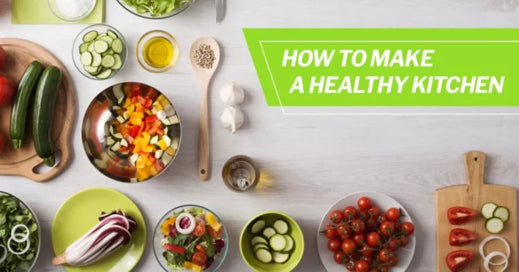Your Cart is Empty

How To Make A Healthy Kitchen
Start with a Clean Slate
The most successful kitchen makeovers begin with getting rid of unhealthy foods; namely, those calorie-dense, nutrient-deficient, high-fat snack foods that only serve to calm emotions, not improve health. Food that comes from the middle of the store, with a few exceptions, should take up very little space in the pantry.
Use these red light, yellow light, and green light guidelines to clear the pantry, refrigerator, and freezer shelves:
RED LIGHT: Potato chips, dips, crackers, cookies, candies, boxed meals, colorful cereal, fruit cups, soda, fruit juice, salad dressing.
YELLOW LIGHT: Whole grain crackers, whole grain bread, canned beans, canned vegetables, dried fruit.
GREEN LIGHT: Olive oil, coconut oil, avocado oil, seasoning blends and spices, whole grains (quinoa, brown rice, oats, whole grain flour, vinegar, dried beans, lentils, nuts, nut butters - natural, unsweetened)
Next, clean and organize the fridge, freezer, and pantry.Look for expiration dates and throw out old food and condiments.
Get the Right Cookware and Dishes
Support healthy eating habits by making meal prep easier. Although a gourmet kitchen is not necessary, certain cookware, dishes, and utensils make it more convenient and less time-consuming. Again, dinner won’t be drive-thru if there are fast, healthy options waiting at home.
First, de-clutter the drawers and cabinets and take an inventory. Compare with the list below:
- Large and small mixing bowls
- Glass casserole dishes
- Baking sheets
- Roasting pans
- Large skillet
- Sauce pots
- Dutch oven
- Peeler
- Grater
- Sharp knives
- Cutting boards – use separate boards for meat, fish, fruits and vegetables, and cheese
- Spatulas
How to Set-Up the Kitchen
Keep mixing bowls, spoons, and measuring cups together. Organize baking sheets, roasting pans, and casserole dishes together. Keep pots, pans, and lids in a cupboard near the stove.
Keep cutting boards and knives close to the prep area. Organize food storage containers here too, to make meal prep faster.
Use canisters for bulk grains like rice, oats, and flour. Store dried herbs and spices away from the stovetop and out of direct sunlight. A tiered spice shelf will keep dried herbs and spices organized and in clear view.
Now that the kitchen is clean and organized, it’s time to stock up on the good stuff.
What to Buy and How to Store It
When it comes to fresh fruits and vegetables, experts recommend eating 5 – 13 servings per day. The best part? Whole foods, like fruits and vegetables are the ultimate fast food—just pick it up and take a bite.
Fresh produce won’t last as long as a jar of processed queso dip, but some fresh foods can hang out in the refrigerator for quite a while. Check out our downloadable handout at the end of this article for a chart of fresh produce storage recommendations.
Nuts add healthy fat into the diet and can be stored at room temperature for about one month. After that, place them in an airtight container and store in the refrigerator. They’ll keep in the fridge for up to six months and in the freezer for up to one year.
When it comes to spices and seasoning blends, here are a couple of general storage guidelines:
- Whole spices like cinnamon sticks, cloves, star anise, and peppercorns have a longer shelf-life than ground spices.
- Use ground spices and seasoning mixes within 6 months of opening.
Stay Hydrated
Dry skin, constipation, headaches, fatigue, and irritability are signs of chronic dehydration. In addition, living in a state of dehydration may impact blood pressure, cause respiratory issues, and increase blood cholesterol.
To inspire better drinking habits, keep a pitcher of fruit water nearby. Fruit-infused water has fewer calories than soda or fruit juice. Delicious flavorings include:
- Lemon
- Grapefruit
- Cucumber and strawberry
- Orange and raspberry
- Watermelon and mint
- Pineapple, mint and ginger
Keep the Freezer Stocked
Rather than stocking the freezer with unhealthy snack foods, leave room for nutritious foods that support a healthy diet. Purchase fresh cuts of lean meat and fatty fish. Divide them into individual portion sizes, place into freezer bags, and label each bag with the date of purchase and type of meat or fish before placing in the freezer.
Store-bought frozen fruits and vegetables are a healthier alternative to canned varieties as they are picked at the peak of ripeness and flash-frozen to maintain flavor.
A better option is to head to the farmer’s market when fruits and veggies are in season and stock up. Wash, dry, and trim the fresh produce, then slice, dice, or chop the ingredients.
Vegetables should be blanched (cooked in boiling water for 1-2 minutes) before being frozen. Fruits should be ripe and the core or pit removed before freezing. Freeze using either of these methods:
- Solid pack: once fresh produce is prepared, place it in the freezer bag, label the bag, and place in the freezer.
- Loose pack: freeze fresh produce in a single layer on baking sheets. Once frozen, transfer to a freezer bag, label, and place in the freezer.
Smoothie recipes can be packaged into individual portion sizes and frozen for a quick breakfast or light dinner option. When labeling the smoothie packs, include blending instructions like what liquids, spices, or powders to add and in what amount.
Add healthy fat and a rich creamy texture to smoothies by adding an avocado to the freezer-pack.
Other Hacks for a Healthy Kitchen
Finally, keeping the kitchen clean reduces the risk of contaminating food and the chance of inviting unwanted guests—like cockroaches, ants, and rodents. After meal prep is done, wipe down kitchen surfaces with warm, soapy water. Keep the sink clean and disinfected and sweep the floor regularly.
Use this information to help you with your nutrition goals. If you have any additional questions feel free to contact me, and I will answer any questions you may have
Ryan